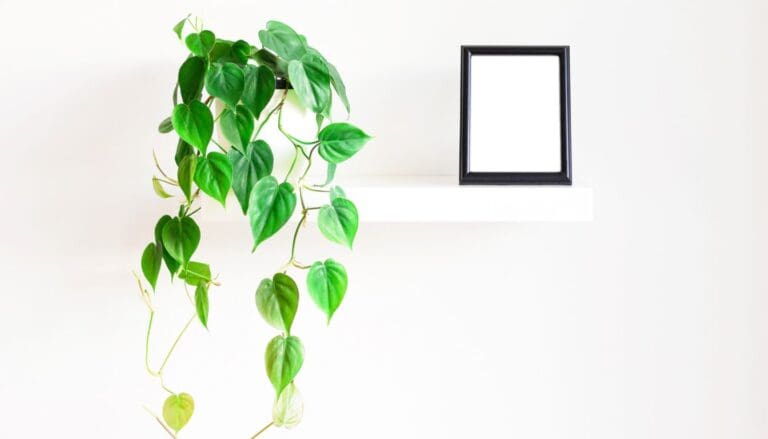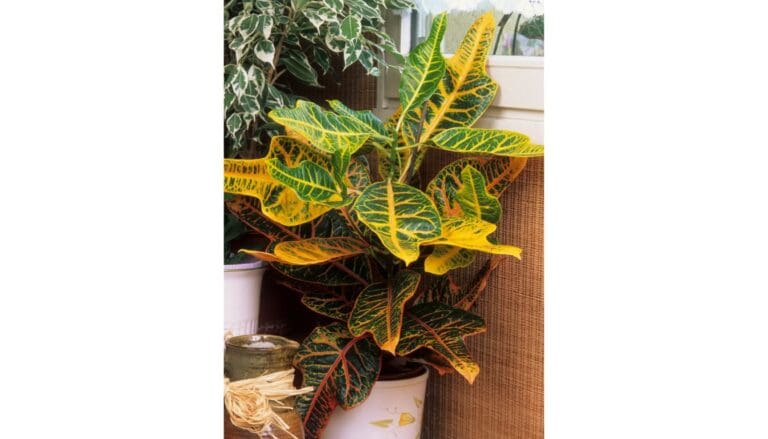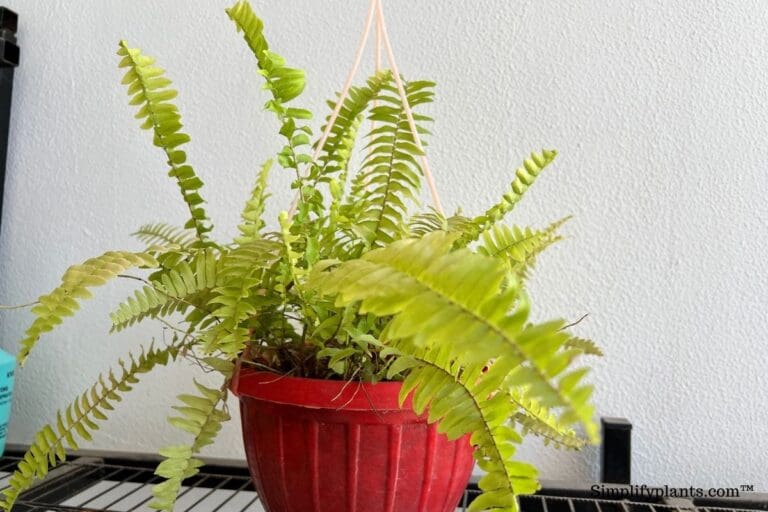7 Reasons Why Your Snake Plant Leaves Are Splitting
When healthy leaves of a snake plant start to split, it could be a matter of concern for every hobbyist. But is it typical for snake plant leaves to split, or is the plant trying to convey you a message? Why is your snake plant leaves splitting? Let’s find out!
Overwatering, physical damage are two major causes of splitting leaves in a snake plant. Snake plant prefers dry and well-draining soil as wet and soggy soil can lead to root rot and splitting of leaves in them. Make sure you protect your snake plant from potential damage by pets and mishandling of the plant.
It is not a big problem, but it’s a message from the snake plants that it wants a bit of your care.
The splitting leaves indicate a few things that we will discuss in this guide. Generally, it might be caused by overwatering or physical damage. However, it could also be other reasons. Let us get into further details.

Please note: Simplify Plants is reader-supported. Some links in the post are affiliate links and I get a commission from purchases made through links in the post.
What causes the snake plant to split?
The snake plant is kept for its beautiful foliage, and that is what makes it look beautiful. The mother-in-law’s tongue never has anything to complain about.
Another reason that this plant is famous is its sturdiness. Yes, you are right! We can keep the plant anywhere, and the plant survives with minimal care.
If you have seen the leaves of the snake plant splitting, it could be because of the below-mentioned reasons;
- Overwatering your Snake plant
- Pests!
- Extreme Environmental Changes
- Physical damage
- Micronutrient Deficiency
- Placement of the Plant
We will discuss all the topics in detail and provide ways to get the issues right and get your snake plant to be happy again.
Overwatering your Snake plant

Anything that goes wrong with your snake plant can be related to the overwatering of your snake plant.
Snake plants are succulents and do not like being overwatered.
It is tough to kill a snake plant. They are very sturdy and can survive through drought conditions, but too much water is not their game.
Succulents, as such, do not need water. The snake plant, in the same way, requires water only when the soil is dry.
Always feel the soil before watering and check if it’s dry. If the soil is moist, we can leave the plant and water it after a few days.
Snake plants absorb water in their leaves, and if we overwater the plant, they will absorb more water and store in the leaves.
During high temperatures, the water from the leaves will transpire at a high rate, and the splitting of the leaves might occur.
Splitting of the leaves is damage to the leaves cells.
How can we avoid overwatering?
We can avoid overwatering by:
- Make a watering regime
- Always feel the soil before watering
- The soil should be dry and not moist
- Check the drainage holes
- Empty the tray that might have excess water
- Snake plants can go without water for three weeks and during winters for about 1-2 months
- Type of potting soil used( should be well-draining)
If we are already suffering from an overwatering condition, then repotting might save your snake plant.
When we choose to repot, repot in well-draining soil and do not add cocopeat to the soil.
Also read: How much water do snake plant needs?
Pests!

Snake plants are not affected by pests, but there are situations like overwatering and overfertilization, causing root rot and inviting the pests.
It could also be that everything is perfect and was healthy still;, our plants are affected by the pest situation. Why is that?
Have you been using rubbing alcohol or disinfectant on the scissors/pruners before your pruning or propagating session?
If the answer to the above question is a NO, then that’s your reason for the pest situation.
Yes, you heard that, right! The golden rule of pruning and propagating the plants is to disinfect your scissors/pruners beforehand.
Disinfecting your scissors and pruners will ensure that pests from
some other plants that could have been infected are not transferred.
Another reason behind the pest situation is the overcrowding of plants.
Pests could have been transferred from other infected plants if kept nearby.
Snake plants are prone to spider mites, mealybugs, and aphids. If we look closely, and we notice white furry balls, it could be spider mites.
When pests infect our snake plants, the first thing that we should do is to isolate the plant from the other plants. This will ensure that our garden is not compromised.
These pests attack the newest leaves first, causing the leaves to turn yellow or brown and even have spots on the leaves.
Pest situation can also cause the splitting of the leaves.
How can we tackle the pest situation?
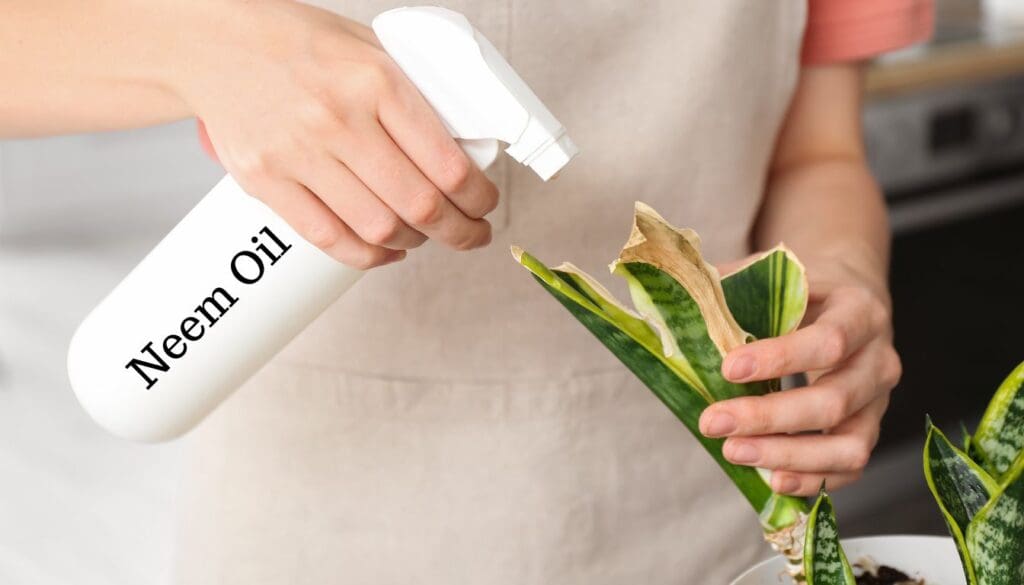
Following the below-mentioned steps will ensure safety:
- Isolate the plant from the others
- Discard any affected leaves as they won’t help the plant
- We can opt for two options being organic or using pesticide
- If we are using organic; Use neem oil solution on the plants
- Take neem oil solution and mix with lukewarm water
- Spray the solution on the Snake plant
- Follow the process for about two weeks to remove the pests and their eggs
- Pesticide can also be used; Always follow the instruction labeled on the pesticide
Check the snake plant often to be sure that there are no pests. In the early stages, it can be removed easily. Later, the snake plant could be at high risk.
Also read: Do snake plant attract pests? (+How to get rid of them)
Extreme Environmental Changes
Though the snake plants are sturdy and do not complain, we can never take things for granted and do as we wish.
Talking about extremes means that we should never move the plant from extreme to another suddenly.
Can someone residing in Iceland adapt to the tropical climate instantly?
It is the same with snake plants. As snake plants can be kept anywhere from low light to direct sunlight, it does not mean that we mishandle them.
For example, if the snake plant was kept in your bathroom with no light but with high humidity and now we want to move the plant to our garden, we cannot do that in one go.
If we want the snake plant to thrive in direct sunlight, we must maintain the environment and provide the necessary changes gradually.
Meaning we might consider keeping the snake plants in direct sunlight for an hour daily for a week and then increasing it to two hours.
This way, the plant will not develop stunted growth and will show signs of positive growth.
Winter is the most crucial time for the snake plant because the snake plant hates the too cold environment.
How can we avoid extremes?
If we want to avoid the extremes:
- During the winters, remove the snake plant from the window still from where it gets a cold draft.
- Another factor to note is the placement of the snake plant near the radiators should be avoided.
- We can use a humidifier to check the humidity level.
- Avoid misting the snake plant altogether.
- Change the location of the plant if necessary.
- If required, we can use artificial light to regulate the temperature.
Physical damage

No one causes damage intentionally to the plants, but it could be damaged. There are numerous reasons behind it, and we will discuss a few so that we can be more careful.
Do you have pets in your house?
Yes, that’s right! Pets get attracted to the plants because it is cooler, and there is also that the pets are more curious.
For example, if cats find monstera leaves, they will surely take a bite or two from the plant, and the monstera is hallucinogenic for the cats.
They might often not want to eat the plant but want to play with it because of the shape and might nibble the plant.
This way, the leaves of the plant could be damaged, and the leaves could start splitting.
Another reason is that if we have ordered the plant online, then maybe due to the transportation, the plant has suffered through the bounces.
This is very important, and we must inspect our plant right before and after purchase.
It could also be that because we mishandled the plant, we might end up damaging them unintentionally.
Sometimes we feel that the plant’s placement was not right and want to move it to some other location.
How can we overcome this?
It is all on you and your care for the plant and how often we look after them. However, we can avoid this by;
- Look for suitable placement of the snake plant. It means that if we have pets or children around the house, then we need to be extra careful.
- Snake plants are mildly toxic to pets and have to be kept at places where both our pets and plants are safe.
- Whenever we leave the house, ensure that the pets and plants are in different rooms.
- The use of hanging pots is also suggested.
- What we often suggest growers with pets is to use Spatial plantation.
- Make use of shelves and cluster the shelf with books and other objects.
- Look for the plants before and after purchase. They might need some help and take time to adapt to the new environment.
Also read: Is snake plant toxic to pets?
Micronutrient Deficiency

The snake plant requires both the micronutrient and the macronutrient for proper growth. We can also use a pH test to identify whether the soil is acidic, alkaline, or neutral.
Boron deficiency is an example of micronutrient deficiency. Splitting of the leaves is caused when the cells of the plant do not develop.
It is the most common issue of micronutrient deficiency in plants. Boron deficiency halts cell development and pauses foliar development.
Boron helps in the transportation of sugar to the plants, and thus it results in foliar development.
How to avoid Boron Deficiency?
- Test your soil and understand the pH level. If the soil is too acidic or too alkaline, it can be maintained
- We can use Boric acid( less than one teaspoon with a gallon of water)
- Remember, snake plants do not like being overfertilized, and over-application could result in damaging the plant further
- If using Boric acid, it should be diluted to a great extent and should only be used to be sprayed in the foliage
- We should consider using more organic substances in the soil
Also read: Do snake plant need fertilizer?
Placement of the Plant

The placement of any houseplant is essential, and the snake plant also has a reputation of Feng-Shui.
However, it could be that the plant is positioned in such a place that it experiences damage without us knowing.
There could be spots in your house that are being used the most such as stairs, maybe the doorways where people pass by regularly.
Because of the high traffic near your plant, someone could accidentally damage the plant, and we are unaware of it.
Another reason is the situation with the pets that we have already covered earlier.
We could have a lot of houseplants together, and they are all kept in the same spot.
Overcrowding could also result in the damage of the snake plant and thus causes splitting of the leaves.
The placement of the plants also causes physical damage.
How can we avoid damage due to placement?
The things to consider are:
- Choose a location where people and pets are not always around.
- If the Snake plant is kept with other plants and the environment is overcrowded, give the plants a bit of space between them.
- We can also use the spatial placement of the Snake plant.
- Also, it is possible to arrange the plants according to Feng-Shui and the least damage from people.
- Hanging pots can be considered for use.
- Let the people know that your plants are around and to be careful near them. Being upfront helps.
Also read: Best placement for snake plant
How to fix leaves splitting in a snake plant?
The snake plants demand minimal care, and we should not neglect the plant. Just giving the plant a bit of attention will help with the prevention of splitting leaves.
We have covered the placement of the plant and the situation of pests.
Along with the above situation, if we want a healthy snake plant, we can follow the below-mentioned points.
Type of Potting soil
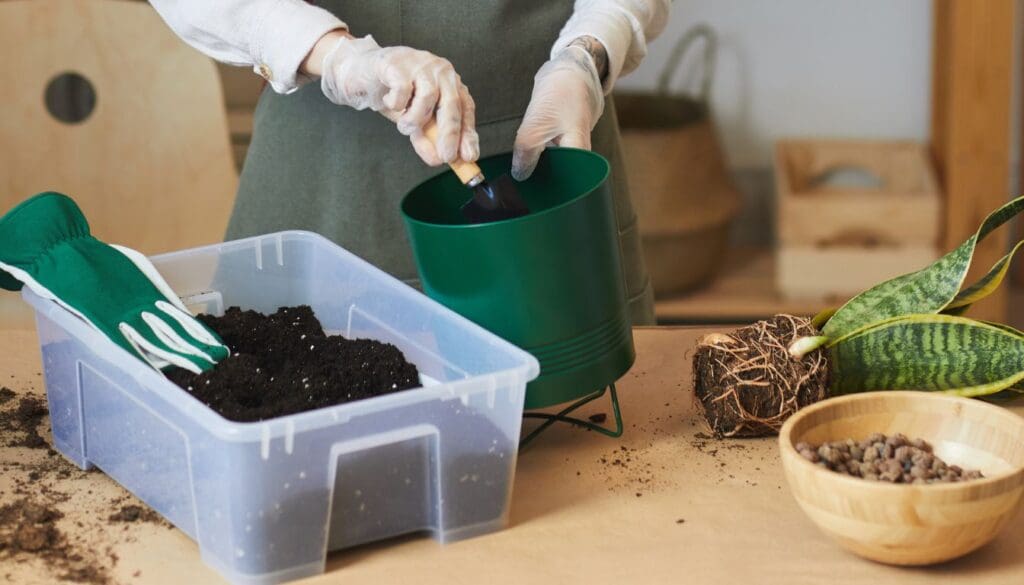
Everything is related to the soil, and the soil should be good for the plant’s healthy growth. It is the soil that the plant absorbs its minerals and nutrients from.
So, while choosing a potting mix for the snake plants, we should use well-draining soil.
While creating a potting soil for the snake plants, we suggest users take potting soil and cactus soil in the ratio of 1:1 and add some compost to the soil.
Compost will maintain the micronutrient and macronutrient factors of the soil.
Also read: What kind of soil do snake plant need?
Watering regime

It is the most vulnerable factor concerning the snake plants because the snake plants do not like being overwatered.
Hence, follow a watering regime and, most importantly, feel the soil before watering the snake plant.
The soil should feel dry and not moist.
Never overwater your snake plants as it might lead to many more issues from which it is challenging getting back.
Also read: Overwatering vs. Underwatering
Location, Location, and Location
Consider placing the plant in a place your pets or children cannot reach because the snake plant is also considered mildly toxic to pets.
Any place where you feel that the plant might be harmed, we should consider providing with supplies that can help, such as fencing or creating boundaries.
The use of spatial plantation is also suggested.
Fertilize but do not Overfertilize

Snake plants can suffer burns and can also develop root rot if it goes through a stunted growth and is overlooked.
Hence, use very diluted fertilizer while fertilizing your snake plants.
In a nutshell, it is easy to keep a snake plant, and keeping it healthy is also very easy. Just a bit of your care and nurture will give beautiful foliage.
Let us know if you have faced any other issues with your snake plant.

Source: The University of Arkansas Division of Agriculture, University of Minnesota, Snake plant profile, Lighting Indoor Houseplants
Recommended Garden Supplies
| Product Image | Our Recommended Gardening Supplies | Check Offers! |
|---|---|---|
Top Top
Top
Top
Top
Top
Top
Top
Top | rePotme Houseplant and Tropical Classic Potting Soil Mix | Check Offer On Amazon |
 Top
Top
Top
Top
Top
Top
Top
Top | Espoma Organic Indoor Plant Food | Check Offer On Amazon |
 Top
Top
Top
Top
Top
Top
Top
Top | GooingTop LED Grow Light 6000K Full Spectrum Clip Plant Growing Lamp | Check Offer On Amazon |
 Top
Top
Top
Top
Top
Top
Top
Top | Soil Moisture Meter | Check Offer On Amazon |
 Top
Top
Top
Top
Top
Top
Top
Top | Govee Hygrometer Thermometer, Bluetooth Enabled! | Check Offer On Amazon |
 Top
Top | LEVOIT Humidifiers for Large Room(Best For Plants) | Check Offer On Amazon |
 Top
Top
Top
Top
Top
Top
Top
Top | Upgraded DIY Automatic Drip Irrigation Kit, 15 Potted Houseplants Support | Check Offer On Amazon |
 Top
Top
Top
Top
Top
Top
Top
Top | Stainless Steel Heavy Duty Gardening Tool Set | Check Offer On Amazon |
 Top
Top
Top
Top
Top
Top
Top
Top | Bonide Insecticidal Soap | Check Offer On Amazon |
 Top
Top
Top
Top
Top
Top
Top
Top | Bonide 32 oz Spray Neem Oil for Organic Gardening | Check Offer On Amazon |
 Top
Top
Top
Top
Top
Top
Top
Top | Garden Safe Fungicide | Check Offer On Amazon |

